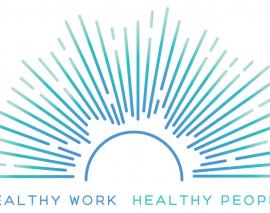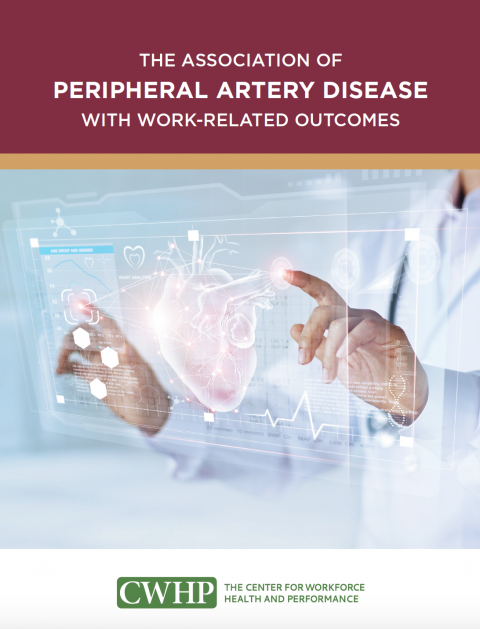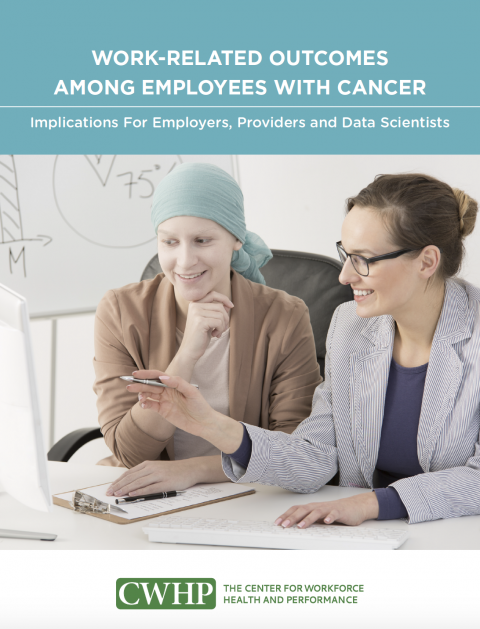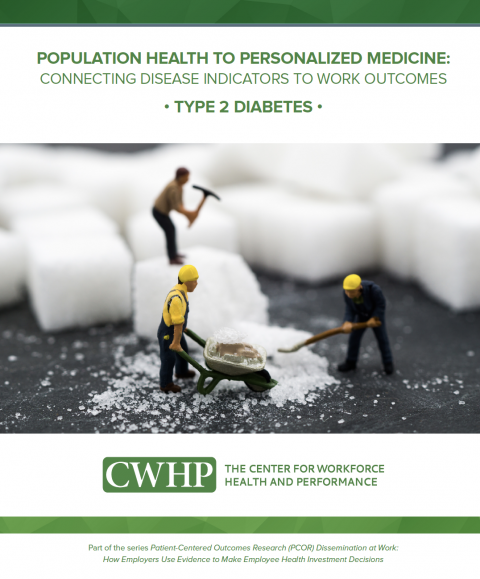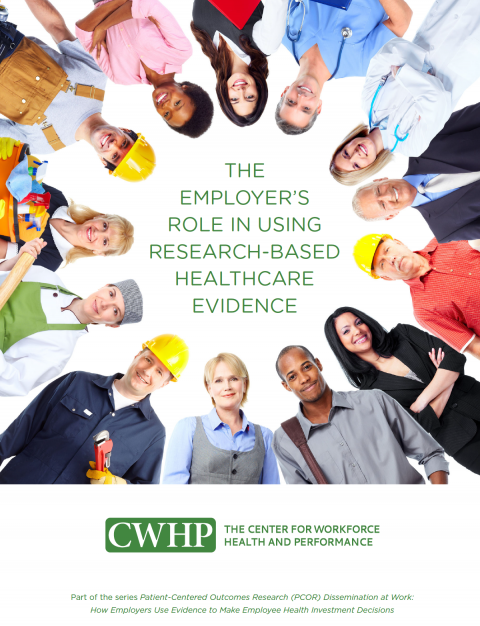Informative research and reports produced by CWHP and aimed at improving our understanding of workforce health and performance, including how to support and improve it.
Research & Reports
Research & Reports
Managing Pain and Treating Musculoskeletal Conditions: A PCORI-sponsored Conference on the Use of Patient-Centered Evidence and Best Practices at Worksite Health Centers
With sponsorhship from the Patient-Centered Outcomes Research Institute (PCORI) (contract EAIN-00102), the CWHP and the National Association of Worksite Health Centers (NAWHC) hosted a virtual symposium on preventing pain and musculoskeletal conditions (MSK), research on managing and treating pain, and integrating providers for improved outcomes. Central to the event was the presentation of findings from PCORI-sponsored research on MSK and pain, setting up discussions of best-practices from occupational health professionals. The report includes a summary of the PCORI studies, a recap of the session discussions, and guidance from participants on how future patient-centered research can close evidence gaps in best practices.
| Attachment | Size |
|---|---|
| 1.54 MB | |
| 157.98 KB |
Innovations in Health and Wellness: Virtual Reality
With this January, 2020 article we launch CWHP's series Innovations in Health and Wellness and highlight the promise of virtual reality to offer new environments in which to learn, heal and perform. This article outlines what we know about virtual reality and its applications in work settings. We explain how this innovation works and what we need to know more about. You'll also find tangible tips and educational links to further investigate and apply this innovation in your own work. Whether you are an employee, employer, health plan, provider or researcher, we hope you find something of interest to act upon in the downloadable report.
| Attachment | Size |
|---|---|
| 1.37 MB |
Leadership & Sustainability: Tips for Long-term & Systemic Results
In this CWHP Blog Article for November, 2019, read about tangible tips and training opportunities for developing leadership for sustainable results. This article outlines the connection between leadership focus and stakeholder value. You will learn useful steps and strategies for leaders to engage a broad range of stakeholders including shareholders, customers, employees and/or the communities in which the leader resides or conducts business. If you want to get beyond a short-term focus you should begin with honest listening and authentic feedback. Whether you are a current or aspiring leader of a commerical, non-profit or public entity, we hope you find something of interest to act upon in the downloadable report.
| Attachment | Size |
|---|---|
| 1.08 MB |
Work: The Good, The Bad and The Precarious
In response to the Business Roundtable press release of August 19, 2019, CWHP reviews the good, the bad and the precarious nature of work today in this Blog Article from October, 2019. As the future of work shifts to a new economic reality for workers, an array of policy and practice solutions should be tried that protect worker health, wellbeing and income security. Whether such solutions are tried by employers, states, or other entities, we need accountability mechanisms and reliable measurement to understand whether the results we desire are achieved. Let's hold ourselves accountable for creating that economic security!
We would like to hear your ideas on how more supportive work can become a reality. Send us your thoughts.
| Attachment | Size |
|---|---|
| 1.51 MB |
Study Summary: Complex Case Management and New Technology
The Center for Workforce Health and Performance (CWHP) will study the outcomes of employee populations after pharmacogenomics are facilitated, case managed, and applied in high-risk, highly complex plan members. In addition to understanding the perspectives of patients and providers, this study will assess the clinical and cost-related outcomes associated with pharmacogenomics in employee populations through administrative data records. For more information on study recruitment click here.
| Attachment | Size |
|---|---|
| 149.46 KB |
Peripheral Artery Disease and Work-related Outcomes
The CWHP report "The Association of Peripheral Artery Disease (PAD) with Work-related Outcomes" presents the results of a study comparing the impact of moderate to severe PAD with mild PAD along with other comorbidities on the incidence and duration of short-term work disability.
This report was partially funded through Merck Sharp & Dohme Corp., a subsidiary of Merck & Co., Inc. The views presented in the report are solely the responsibility of the author and do not necessarily represent the views of the sponsoring organization nor collaborators on the study.
If PAD cases can be managed in a way that prevents mild cases from becoming moderate/severe then employees and employers may benefit from less work disruption due to fewer cases of short-term work disability. Key to success is a focus on complex case management and the other comorbidities that these patients may have. By adopting a patient-centered approach to prevention, treatment access and improved outcomes we should expect greater focus on functional and quality of life outcomes that matter to individuals. For those in the workforce, being able to attend work, perform well on the job and stay at work or return to work in a timely and healthy fashion should a period of work disability occur is critical for the continued physical and socioeconomic health of the individual and their contributions to corporate success.
| Attachment | Size |
|---|---|
| 2.13 MB |
Cancer and Work-related Outcomes
The CWHP report "Work-Related Outcomes Among Employees With Cancer" presents a selected summary of recent research on the importance of stay at work and return to work outcomes for workers with cancer as well as a descriptive analysis of short-term work disability experience across six types of cancer for a multi-employer population of workers.
This report was partially funded through PhRMA. The views presented in the report are solely the responsibility of the author and do not necessarily represent the views of the sponsoring organization nor collaborators on the study.
Access to high quality and appropriate treatment for cancer may mitigate the effects of work performance loss and prevent longer term periods of work disability and income disruption. Support can also be offered through employee assistance programs including guidance around caregiver support for employees with family members who have cancer. Employers, providers and data scientists can all support the inclusion of the right data, resources and treatment to affect longer, healthier and more fulfilling working lives for employees with cancer.
| Attachment | Size |
|---|---|
| 2.07 MB |
Population Health to Personalized Medicine: Connecting Disease Indicators to Work Outcomes - Diabetes
The CWHP report "Population Health to Personlized Medicine: Connecting Disease Indicators to Work Outcomes - Type 2 Diabetes" presents a framework for connecting disease indicators of diabetes to a variety of work outcomes including absence, job performance, work disability and permanent departure from the workforce. The framework outlines connections between clinical and employer perspectives around worker health and suggests a variety of ways to improve diagnosis and treatment for better health and work-related outcomes.
This series was partially funded through a Patient-Centered Outcomes Research Institute (PCORI) Eugene Washington PCORI Engagement Award (#2970-CWHP). The views presented in this series are solely the responsibility of the author(s) and do not necessarily represent the views of the Patient-Centered Outcomes Research Institute (PCORI), its Board of Governors or Methodology Committee.
If you would like to be involved in the development of reports, webinars and learning opportunities for this series -- Patient‐Centered Outcomes Research (PCOR) Dissemination at Work: How Employers Use Evidence to Make Employee Health Investment Decisions -- please contact Dr. Kimberly Jinnett at kjinnett@tcwhp.org.
| Attachment | Size |
|---|---|
| 1.25 MB |
How Employers Use Evidence to Make Employee Health Investment Decisions
The CWHP report "The Employer's Role in Using Research-Based Healthcare Evidence" presents findings and recommendations from a series of interviews with employers and their programmatic solutions partners.
This series was partially funded through a Patient-Centered Outcomes Research Institute (PCORI) Eugene Washington PCORI Engagement Award (#2970-CWHP). The views presented in this series are solely the responsibility of the author(s) and do not necessarily represent the views of the Patient-Centered Outcomes Research Institute (PCORI), its Board of Governors or Methodology Committee.
If you would like to comment on pre-publication versions of content developed for this series -- Patient‐Centered Outcomes Research (PCOR) Dissemination at Work: How Employers Use Evidence to Make Employee Health Investment Decisions -- please contact Dr. Kimberly Jinnett at kjinnett@tcwhp.org.
Documents include an employer interview summary report and frameworks tracking clinical indicators to work outcomes for five groups (diabetes, depression, cancer, pain and multimorbidity). Look for webinars and other engagement opportunities to follow.
| Attachment | Size |
|---|---|
| 1.71 MB |
Worker Well-being and High Performance Workplaces: Two Sides of the Same Coin
Worker well-being and high performance workplaces are fundamentally linked to each other; we argue that it is difficult to have one without the other. Of course, how well-being and performance are defined is central to the argument of whether you truly can have one without the other. What does it mean to have a high performance workplace? How do we define and think about employee well-being and how it contributes to business value? These and other topics are explored along with selected research and evidence on these topics.
Download the slide deck with notes presented at the 2nd International Symposium to Advance Total Worker Health held on May 9, 2018 in Bethesda Maryland.
Please contact Dr. Kimberly Jinnett at kjinnett@tcwhp.org if you have any questions or comments about this presentation.
| Attachment | Size |
|---|---|
| 6.88 MB |






